高中英语语法——独立主格结构
- 格式:doc
- 大小:51.00 KB
- 文档页数:4

高中英语语法:独立主格结构的七种形式1. 名词(代词)+现在分词 The question being settled, we went home. 问题解决之后,我们就回家了。
We shall play the match tomorrow, weather permitting. 明天假设天气好,我们就进行比赛。
The monitor be1. 名词(代词)+现在分词The question being settled, we went home. 问题解决之后,我们就回家了。
We shall play the match tomorrow, weather permitting. 明天假设天气好,我们就进行比赛。
The monitor being ill, we’d better put the meeting off.班长病了,我们最好还是延期开会吧。
2. 名词(代词)+过去分词The job finished, we went home. 工作结束后我们就回家了。
The last bus having gone, we had to walk home. 最后一班公车已经走了,我们必须走路回家。
More time given, we should have done the job much bett er. 如果给我们更多的时间,我们会把工作做得更好。
3. 名词(代词)+不定式Nobody to come tomorrow, we will have to put off the m eeting till next week. 如果明天没有人来,我们将把会议推迟到下周。
So many people to help him, he is sure to succeed. 有如此多的人来帮助他,他一定会成功的。
4. 名词(代词)+介词短语The soldiers dashed in, rifle in hand. 士兵们端着枪冲了进来。
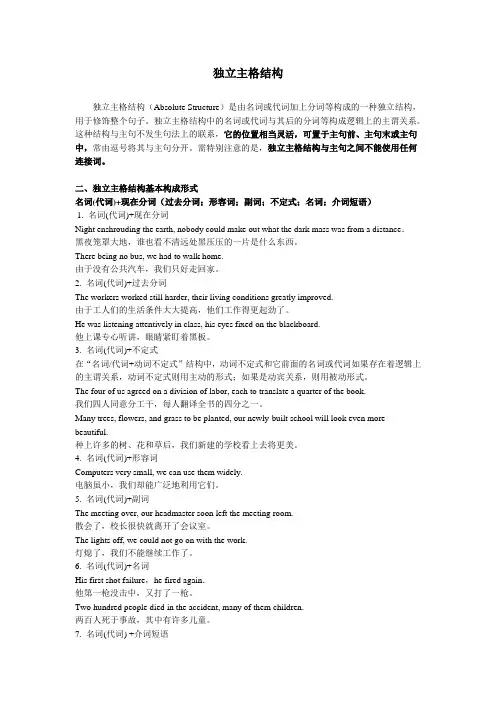
独立主格结构独立主格结构(Absolute Structure)是由名词或代词加上分词等构成的一种独立结构,用于修饰整个句子。
独立主格结构中的名词或代词与其后的分词等构成逻辑上的主谓关系。
这种结构与主句不发生句法上的联系,它的位置相当灵活,可置于主句前、主句末或主句中,常由逗号将其与主句分开。
需特别注意的是,独立主格结构与主句之间不能使用任何连接词。
二、独立主格结构基本构成形式名词(代词)+现在分词(过去分词;形容词;副词;不定式;名词;介词短语)1. 名词(代词)+现在分词Night enshrouding the earth, nobody could make out what the dark mass was from a distance.黑夜笼罩大地,谁也看不清远处黑压压的一片是什么东西。
There being no bus, we had to walk home.由于没有公共汽车,我们只好走回家。
2. 名词(代词)+过去分词The workers worked still harder, their living conditions greatly improved.由于工人们的生活条件大大提高,他们工作得更起劲了。
He was listening attentively in class, his eyes fixed on the blackboard.他上课专心听讲,眼睛紧盯着黑板。
3. 名词(代词)+不定式在“名词/代词+动词不定式”结构中,动词不定式和它前面的名词或代词如果存在着逻辑上的主谓关系,动词不定式则用主动的形式;如果是动宾关系,则用被动形式。
The four of us agreed on a division of labor, each to translate a quarter of the book.我们四人同意分工干,每人翻译全书的四分之一。
Many trees, flowers, and grass to be planted, our newly-built school will look even more beautiful.种上许多的树、花和草后,我们新建的学校看上去将更美。
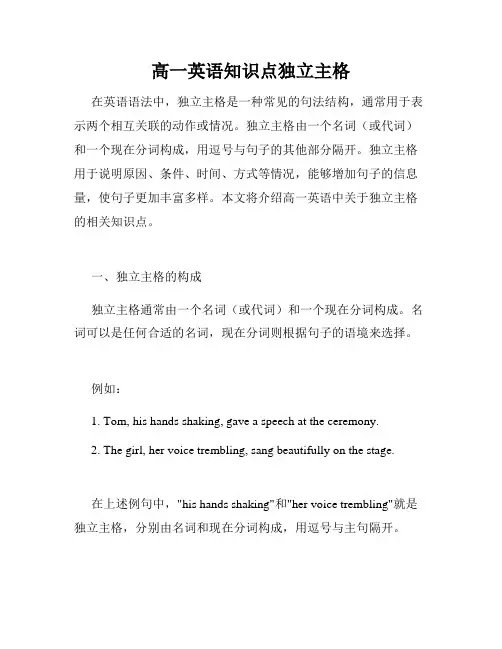
高一英语知识点独立主格在英语语法中,独立主格是一种常见的句法结构,通常用于表示两个相互关联的动作或情况。
独立主格由一个名词(或代词)和一个现在分词构成,用逗号与句子的其他部分隔开。
独立主格用于说明原因、条件、时间、方式等情况,能够增加句子的信息量,使句子更加丰富多样。
本文将介绍高一英语中关于独立主格的相关知识点。
一、独立主格的构成独立主格通常由一个名词(或代词)和一个现在分词构成。
名词可以是任何合适的名词,现在分词则根据句子的语境来选择。
例如:1. Tom, his hands shaking, gave a speech at the ceremony.2. The girl, her voice trembling, sang beautifully on the stage.在上述例句中,"his hands shaking"和"her voice trembling"就是独立主格,分别由名词和现在分词构成,用逗号与主句隔开。
二、独立主格的用法1. 表示原因当独立主格表示原因时,它往往用于解释一个动作或情况的原因。
例如:1. The weather being fine, we decided to go for a picnic.2. The deadline approaching, he worked day and night to finish the project.2. 表示条件独立主格可用于表示一个动作或情况发生的条件或前提。
例如:1. The exam finished, the students were relieved.2. The rain stopping, we went out for a walk.3. 表示时间独立主格可以用来表示与主句的动作或情况同时发生的时间。
例如:1. The bell ringing, the students lined up for class.2. The sun setting, the sky turned a beautiful shade of orange.4. 表示方式独立主格用于描述主句中的动作或情况的方式或态度。
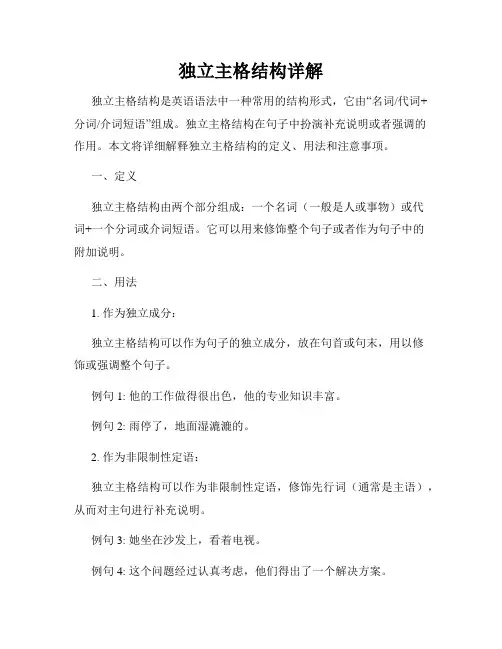
独立主格结构详解独立主格结构是英语语法中一种常用的结构形式,它由“名词/代词+分词/介词短语”组成。
独立主格结构在句子中扮演补充说明或者强调的作用。
本文将详细解释独立主格结构的定义、用法和注意事项。
一、定义独立主格结构由两个部分组成:一个名词(一般是人或事物)或代词+一个分词或介词短语。
它可以用来修饰整个句子或者作为句子中的附加说明。
二、用法1. 作为独立成分:独立主格结构可以作为句子的独立成分,放在句首或句末,用以修饰或强调整个句子。
例句1: 他的工作做得很出色,他的专业知识丰富。
例句2: 雨停了,地面湿漉漉的。
2. 作为非限制性定语:独立主格结构可以作为非限制性定语,修饰先行词(通常是主语),从而对主句进行补充说明。
例句3: 她坐在沙发上,看着电视。
例句4: 这个问题经过认真考虑,他们得出了一个解决方案。
3. 作为插入语:独立主格结构可以作为插入语,用以引起读者的注意或者加强语气。
例句5: 天气晴朗,阳光明媚,我们决定去郊外野餐。
例句6: 雨停了,风起了,天空顿时恢复了明朗。
三、注意事项1. 独立主格结构的主体和主句主体应一致;2. 如果是一般过去时或一般将来时,独立主格结构的动词需使用过去分词形式;3. 使用独立主格结构时应注意逗号的使用及位置。
总结:独立主格结构是英语语法中的一个重要结构形式,用以修饰、强调句子或补充说明主句内容。
通过使用独立主格结构,我们可以让句子更加丰富、生动,同时也能够更准确地表达出我们想要表达的意思。
在使用独立主格结构时,我们要注意主体一致性、动词形式以及逗号的使用等方面。
通过对独立主格结构的详细解释,相信读者们对其在句中的使用已有了更深入的了解。
在日常写作和口语表达中,希望大家能够灵活运用这一结构,使语言更加精彩。

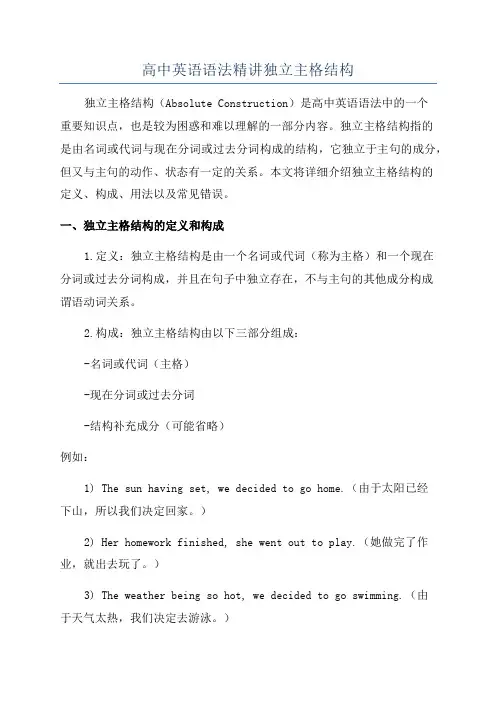
高中英语语法精讲独立主格结构独立主格结构(Absolute Construction)是高中英语语法中的一个重要知识点,也是较为困惑和难以理解的一部分内容。
独立主格结构指的是由名词或代词与现在分词或过去分词构成的结构,它独立于主句的成分,但又与主句的动作、状态有一定的关系。
本文将详细介绍独立主格结构的定义、构成、用法以及常见错误。
一、独立主格结构的定义和构成1.定义:独立主格结构是由一个名词或代词(称为主格)和一个现在分词或过去分词构成,并且在句子中独立存在,不与主句的其他成分构成谓语动词关系。
2.构成:独立主格结构由以下三部分组成:-名词或代词(主格)-现在分词或过去分词-结构补充成分(可能省略)例如:1) The sun having set, we decided to go home.(由于太阳已经下山,所以我们决定回家。
)2) Her homework finished, she went out to play.(她做完了作业,就出去玩了。
)3) The weather being so hot, we decided to go swimming.(由于天气太热,我们决定去游泳。
)二、独立主格结构的用法独立主格结构常用于下面几种情况:1.表示主句和从句发生的动作同时进行例如:- The teacher leaving the room, the students began to talk.(老师离开教室,学生们就开始聊天。
)2.表示原因、条件或时间例如:- The story being interesting, I couldn't help but read it all night.(由于这个故事很有趣,所以我忍不住整夜读完了它。
)3.表示伴随、结果或程度例如:- His hands trembling, he couldn't hold the cup steady.(他的手颤抖着,无法将杯子稳住。
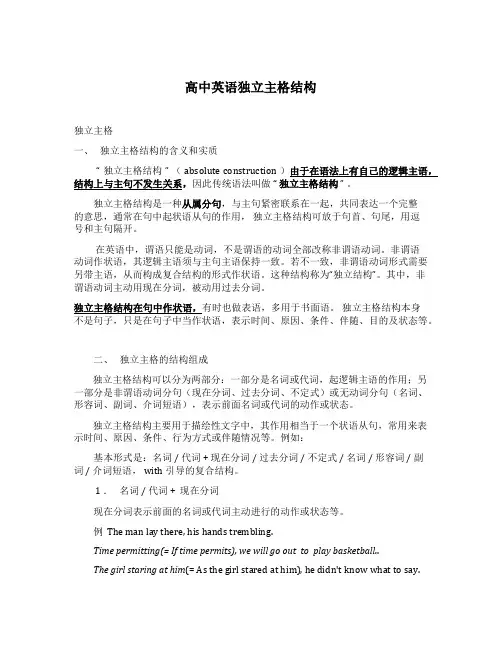
高中英语独立主格结构独立主格一、独立主格结构的含义和实质“ 独立主格结构” ( absolute construction )由于在语法上有自己的逻辑主语,结构上与主句不发生关系,因此传统语法叫做“ 独立主格结构” 。
独立主格结构是一种从属分句,与主句紧密联系在一起,共同表达一个完整的意思,通常在句中起状语从句的作用,独立主格结构可放于句首、句尾,用逗号和主句隔开。
在英语中,谓语只能是动词,不是谓语的动词全部改称非谓语动词。
非谓语动词作状语,其逻辑主语须与主句主语保持一致。
若不一致,非谓语动词形式需要另带主语,从而构成复合结构的形式作状语。
这种结构称为“独立结构”。
其中,非谓语动词主动用现在分词,被动用过去分词。
独立主格结构在句中作状语,有时也做表语,多用于书面语。
独立主格结构本身不是句子,只是在句子中当作状语,表示时间、原因、条件、伴随、目的及状态等。
二、独立主格的结构组成独立主格结构可以分为两部分:一部分是名词或代词,起逻辑主语的作用;另一部分是非谓语动词分句(现在分词、过去分词、不定式)或无动词分句(名词、形容词、副词、介词短语),表示前面名词或代词的动作或状态。
独立主格结构主要用于描绘性文字中,其作用相当于一个状语从句,常用来表示时间、原因、条件、行为方式或伴随情况等。
例如:基本形式是:名词 / 代词 + 现在分词 / 过去分词 / 不定式 / 名词 / 形容词 / 副词 / 介词短语, with 引导的复合结构。
1 .名词 / 代词 + 现在分词现在分词表示前面的名词或代词主动进行的动作或状态等。
例 The man lay there, his hands trembling.Time permitting(= If time permits), we will go out to play basketball..The girl staring at him(= As the girl stared at him), he didn't know what to say.注:“ 独立结构” 中的 being 或 having been 有时可以省去,这样就成了无动词分句或过去分词分句。
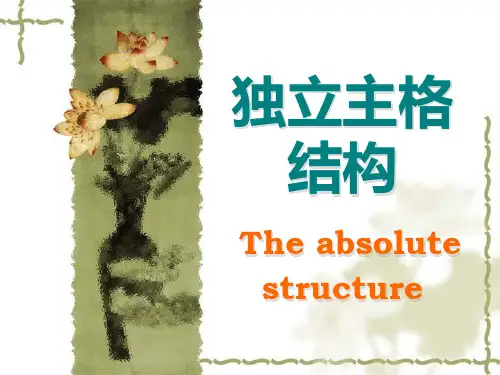
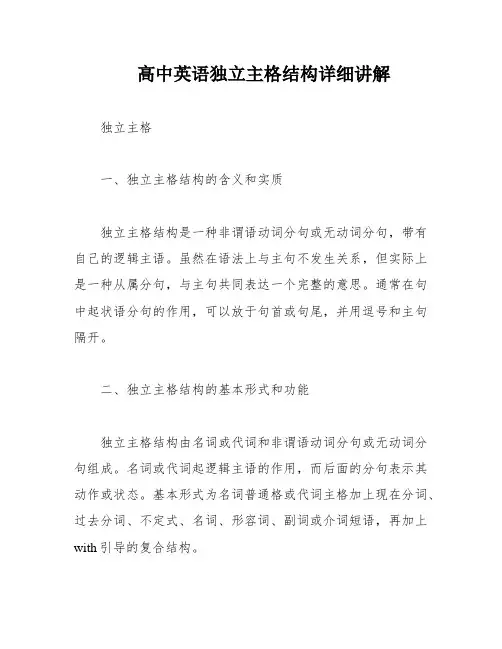
高中英语独立主格结构详细讲解独立主格一、独立主格结构的含义和实质独立主格结构是一种非谓语动词分句或无动词分句,带有自己的逻辑主语。
虽然在语法上与主句不发生关系,但实际上是一种从属分句,与主句共同表达一个完整的意思。
通常在句中起状语分句的作用,可以放于句首或句尾,并用逗号和主句隔开。
二、独立主格结构的基本形式和功能独立主格结构由名词或代词和非谓语动词分句或无动词分句组成。
名词或代词起逻辑主语的作用,而后面的分句表示其动作或状态。
基本形式为名词普通格或代词主格加上现在分词、过去分词、不定式、名词、形容词、副词或介词短语,再加上with引导的复合结构。
1.名词/代词+现在分词现在分词表示前面的名词或代词主动进行的动作或状态等。
例如:The man lay there。
his hands trembling.So many students were absent that the meeting had to be put off.Tom went to sleep after finishing XXX.2.名词/代词+过去分词过去分词表示前面的名词或代词被动完成的动作或所处的一种状态。
例如:The boy lay on his back。
his hands crossed under his head.The job was not finished。
so we couldn't see the film.XXX。
and XXX.3.名词/代词+不定式不定式表示将来的动作。
例如:XXX going for a ic。
with Mary providing the food.These are the first two books。
with the third one set to be released next month。
We will gather at 7:30.and the n will begin XXX 8.Many people。
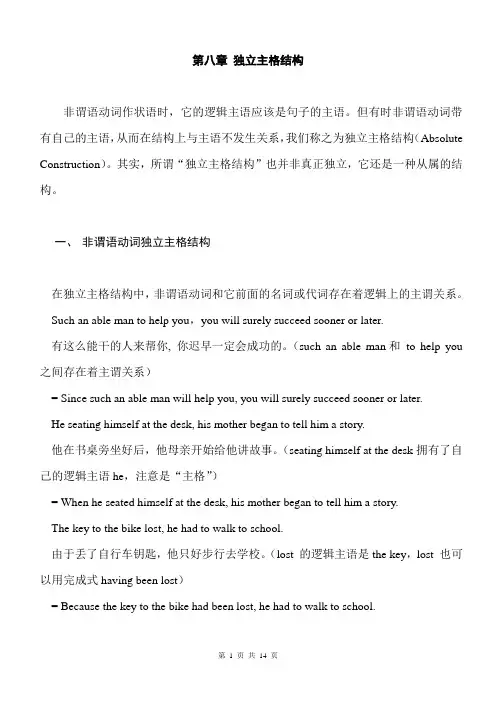
第八章独立主格结构非谓语动词作状语时,它的逻辑主语应该是句子的主语。
但有时非谓语动词带有自己的主语,从而在结构上与主语不发生关系,我们称之为独立主格结构(Absolute Construction)。
其实,所谓“独立主格结构”也并非真正独立,它还是一种从属的结构。
一、非谓语动词独立主格结构在独立主格结构中,非谓语动词和它前面的名词或代词存在着逻辑上的主谓关系。
Such an able man to help you,you will surely succeed sooner or later.有这么能干的人来帮你, 你迟早一定会成功的。
(such an able man和to help you 之间存在着主谓关系)= Since such an able man will help you, you will surely succeed sooner or later.He seating himself at the desk, his mother began to tell him a story.他在书桌旁坐好后,他母亲开始给他讲故事。
(seating himself at the desk拥有了自己的逻辑主语he,注意是“主格”)= When he seated himself at the desk, his mother began to tell him a story.The key to the bike lost, he had to walk to school.由于丢了自行车钥匙,他只好步行去学校。
(lost 的逻辑主语是the key,lost 也可以用完成式having been lost)= Because the key to the bike had been lost, he had to walk to school.A.不定式“独立主格结构”在“逻辑主语+动词不定式”结构中,动词不定式和它前面的名词或代词存在着逻辑上的主谓关系。
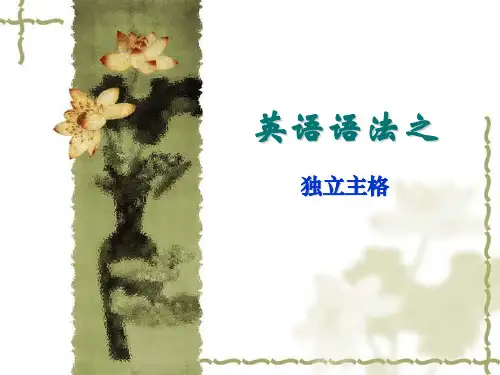
高中英语知识点归纳独立主格结构的构成与应用高中英语知识点归纳:独立主格结构的构成与应用独立主格结构是英语语法中的一种常见结构,它由名词或代词加上现在分词或过去分词构成,起到修饰句子其他成分或表达某种程度的状态或情感的作用。
在句子中,独立主格结构位于主句之外,通常用逗号与主句分开。
独立主格结构是高中英语考试中常常涉及的一个知识点,理解和掌握其构成和应用对于英语学习者来说至关重要。
本文将对独立主格结构的构成和应用进行归纳总结。
一、独立主格结构的构成独立主格结构由以下两部分构成:1. 名词或代词:独立主格结构的首部是一个名词或代词,代表着某个人、事物或概念。
2. 现在分词或过去分词:独立主格结构的尾部是一个现在分词或过去分词,表示该名词或代词所承担的动作或状态。
例如:1. 他站在门口,双手插袋,眼神呆滞。
这里,“他”是名词,表示某个人;“站”是现在分词,表示动作;整个结构“他站在门口,双手插袋,眼神呆滞”构成独立主格结构。
2. 天气变暖,花鸟时节又来临了。
这里,“天气”是名词,表示某个事物;“变暖”是现在分词,表示状态;整个结构“天气变暖,花鸟时节又来临了”构成独立主格结构。
二、独立主格结构的应用独立主格结构在句子中有多种应用方式,主要包括以下几个方面:1. 表达伴随状态:独立主格结构可以用来表达句子主语的伴随状态,起到修饰或补充的作用。
例如:- 他们面对困难,毫不退缩。
- 她举着小花,微笑着招手。
2. 表示原因或理由:独立主格结构可以用来表示句子中某个动作或状态的原因或理由。
例如:- 天气寒冷,路上的行人渐渐减少。
- 时间紧迫,我们必须加快工作的进度。
3. 强调句子中的主语:独立主格结构可以用来强调句子的主语,使主语更加突出,给人深刻的印象。
例如:- 他的成绩优异,全校都知道。
- 他的演讲令人振奋,大家纷纷鼓掌。
4. 表示结果或后果:独立主格结构可以用来表示某个动作或状态的结果或后果。
例如:- 失去父母的关爱,他长大后变得孤僻。
高中英语语法独立主格结构知识点总结高中英语语法独立主格结构知识点总结在高中英语语法学习中,独立主格结构是一个比较重要的概念。
独立主格结构是英语中的一种非常常见的语法结构。
学生们掌握了这种语法结构,可以更有效地理解和运用英语,提高英语写作和表达能力。
本文将从什么是独立主格结构,独立主格结构的形式和使用方法,以及独立主格结构的注意事项三个方面来对独立主格结构进行总结。
一、什么是独立主格结构独立主格结构是英语中的一种短语结构,一般由名词或代词+ v-ing, v-ed, v-en 等过去分词/现在分词构成,作状语,表示动作发生的时间、原因、条件、结果等状况。
独立主格结构不需要和主语、谓语、宾语相互连接,可以单独存在于一个句子中,用来修饰整个句子或表示附加的信息。
通常用逗号将独立主格结构与整个句子隔开。
例如:- 听到这个消息,他非常惊讶。
Hearing the news, he was very surprised.- 天气很晴朗,阳光明媚,大道上行人如织。
The weather is sunny, the sun is shining, and the pedestrians on the avenue are crowded.二、独立主格结构的形式和使用方法独立主格结构通常由名词或代词和动词-ing, -ed, -en等过去分词/现在分词构成,这种结构在英语中较为常见,经常用于表达附加的信息,并且在句子中常常被用作修饰语。
独立主格结构在英语写作中通常用来丰富文章的表达形式和简明表达。
例如:- 看到这张照片,我一下子就想到了我那些美好的回忆。
Seeing this picture, I was immediately reminded of my happy memories.- 考虑到这个问题非常复杂,我们需要更多的时间来解决它。
Considering that the problem is very complex, we need more time to solve it.值得注意的是,独立主格结构要注意它的使用方法。
独立主格结构:独立主格结构,又叫独立结构(absolute construction).它在句法上游离与句子主体之外,跟主句没有任何语法联系;但在意义上却与主句紧密联系在一起,给他构成一个完整的寓意环境。
独立主格结构没有主语和位于,只有逻辑上的主语,因此,它在句法上不是句子,而是一个独立于句子成分之外的独特结构形式。
独立主格结构可置于句首、句尾,用逗号上与主句隔开。
一、独立主格结构的形式独立结构可分为俩部分,一部分事名词或代词(主格),起着逻辑主语的作用;另一部分由形容词、副词、名词、分词、不定式、介词短语等构成,表示前面名词或代词的状态或动作。
1)名词/代词+形容词I heard that she got injured in the accident , my heart full of worry. 我听说她在这次事故中受了伤,内心充满担忧。
He stood silent in the moon-light, his door open .月光下,门开着,他默默地站在那。
2)名词/代词+现在分词Winter coming ,it gets colder and colder. 冬天来了,天气越来越冷了。
The rain having stopped ,he went out for a walk. 雨停了,他出去散散步。
3)名词/代词+过去分词More time given ,we should have done it much better. 如果给我们更多时间,我们会做的更好。
The boy stood there , his right hand raised. 那个男生站在那里,右手高举。
4)名词/代词(主格)+不定式Here are the first two volumes , the third one to come out next month.这是前俩卷,第三卷将于下雨问世。
高中英语知识点:独立主格结构什么是独立主格结构?独立主格结构是英语语法中的一个特殊结构,由一个名词或代词和一个动词的现在分词形式而成。
这个结构在句子中无法被省略,但也不属于主语、宾语、或其他从句。
通常用于强调一个动作或状态,或用来表示补充说明。
例如:•时间一到,他的心情就异常兴奋,站在门口等待着来访的朋友。
在上面的句子中,独立主格结构是“站在门口等待着来访的朋友”,它的作用是为前面的句子“时间一到,他的心情就异常兴奋”提供进一步的解释说明。
独立主格结构的组成一般来说,独立主格结构由一个名词或代词和一个动词的现在分词形式组成。
名词或代词是独立主格的核心,而动词的现在分词形式则指出了该核心所表示的动作或状态。
下面是一些例子:•你的祝福,让我无比感动。
•天气晴朗,我们决定出去玩。
•大雨倾盆,我们只能坐在车里等。
在上面的例子中,独立主格的核心是“你的祝福”,“天气晴朗”,和“大雨倾盆”,而后面的动词分别是“让我无比感动”,“决定出去玩”,和“我们只能坐在车里等”。
独立主格的用法独立主格结构可以用于许多不同的情形,通常用于以下几种情况:补充说明或修饰独立主格结构常常用于对主句进行补充说明或修饰。
它可以提供进一步的信息,使句子更加清晰、生动。
例如:•星期天早上,阳光明媚,鸟儿在树上欢快地唱着歌。
•在校园里,我们看到了绿树成荫,芳草萋萋的美景。
•他回到家里,发现屋子里一片狼藉。
在上述句子中,独立主格结构分别是“阳光明媚”,“绿树成荫,芳草萋萋的美景”,和“屋子里一片狼藉”,它们都用来修饰或补充主句。
强调独立主格结构也可以用于强调一个动作或状态。
这个结构可以使句子更加生动有力。
例如:•饭菜已经凉了,可客人依然在等待着。
•彩虹横跨天际,惊艳了所有路过的人。
•学生们排队等候进入教室,教师却迟迟未到。
在上面的句子中,独立主格结构分别是“客人依然在等待着”,“惊艳了所有路过的人”,和“教师却迟迟未到”,它们都用来强调相应的动作或状态。
独立主格结构:独立主格结构,又叫独立结构(absolute construction).它在句法上游离与句子主体之外,跟主句没有任何语法联系;但在意义上却与主句紧密联系在一起,给他构成一个完整的寓意环境。
独立主格结构没有主语和位于,只有逻辑上的主语,因此,它在句法上不是句子,而是一个独立于句子成分之外的独特结构形式。
独立主格结构可置于句首、句尾,用逗号上与主句隔开。
一、独立主格结构的形式独立结构可分为俩部分,一部分事名词或代词(主格),起着逻辑主语的作用;另一部分由形容词、副词、名词、分词、不定式、介词短语等构成,表示前面名词或代词的状态或动作。
1)名词/代词+形容词I heard that she got injured in the accident , my heart full of worry. 我听说她在这次事故中受了伤,内心充满担忧。
He stood silent in the moon-light, his door open .月光下,门开着,他默默地站在那。
2)名词/代词+现在分词Winter coming ,it gets colder and colder. 冬天来了,天气越来越冷了。
The rain having stopped ,he went out for a walk. 雨停了,他出去散散步。
3)名词/代词+过去分词More time given ,we should have done it much better. 如果给我们更多时间,我们会做的更好。
The boy stood there , his right hand raised. 那个男生站在那里,右手高举。
4)名词/代词(主格)+不定式Here are the first two volumes , the third one to come out next month.这是前俩卷,第三卷将于下雨问世。
独立主格一、独立主格结构(the absolute structure)用于修饰整个句子,而不是一个词或词组。
独立主格结构中的名词或代词与其后的分词或分词短语构成逻辑上的主谓关系。
这种结构与主句不发生句法上的联系,独立主格结构的位置相当灵活,可置于主句前、主句末或主句中,常由逗号将其与主句分开。
需特别注意的是,独立主格结构与主句之间不能使用任何连接词。
二、独立主格结构的特点:1独立主格结构的逻辑主语与句子的主语不同,它独立存在。
2名词或代词与后面的分词,形容词,副词,不定式,介词等是主谓关系。
3独立主格结构一般有逗号与主句分开。
4)在句中作状语,并对主句进行补充说明。
5)它有自己逻辑上的主语,表达相对独立的意思三、构成1、名词/代词+ to doWe divide the work, he to clean windows and I to sweep the floor.The last guest to arrive, our party was started. 最后一位客人到了,我们的晚会开始了。
2、名词/代词+ doingIt being fine, we decided to go for a picnic.There being no bus or taxi then, we had to walk home.There being nothing else to do, we left.The problem having been settled, we ended our meeting.The clock having struck 12, I went to bed.(1).__________no bus, we had to walk home. (A)A .There beingB .BeingC .Having beenD .There was(2)._______no bus, we had to walk home. (b)A .As there beingB .As there wasC .BeingD .There was(3)._______Sunday, the library doesn't open. (c)A .BeingB .There beingC .It beingD .Having been(4).______Sunday, the library doesn't open. (d or It being)A .As it beingB .BeingC .It isD .As it is3、名词/代词+ doneHis voice drowned by the noise, the speaker interrupted his lecture.Her wallet stolen, she had no money to buy even a bus ticket.因为钱包被偷了,她甚至连买车票的钱也没有了。
The experiment done, the students went on to take notes in the experiment report. 实验做完了,同学们继续在实验报告上做记录。
(1).______a___, the train started.A .The signal givenB .Giving the signal B .The signal being given D .The signal giving(2).____d______, the train started.A .After having given the signalB .After the signal givenC .Giving the signalD .After the signal was given(3).____b_____, the text became easier for us to learn.A .Explaining new wordsB .New words explainedC .Being explained new wordsD .Having explained new words(4).______a________, the text became easier for us to learn.A. When new words were explained B .Explaining new wordsC .New words explainingD .Being explained new words4、名词/代词+adj. / adv.I saw deep pools, the water blue like the sky.我看见深深的池塘里,水蓝蓝的像天空。
The condition (being) favorable, he may succeed.条件有利的话,他可能成功。
Summer (being) over, students returned to school.夏天过去了,学生回到了学校。
All the lights on, our classroom building looks even more beautiful.Computers being very small, we can use them widely. 电脑虽小,但用途却很广泛。
(1)._____b or Conditions being better______, the patient can leave the hospital.A .Better conditionsB .Conditions betterC .Conditions are betterD .Being better conditions (2).___c______, the patient can leave the hospital.A .If better conditionsB .If conditions betterC .If conditions are better D. Being better conditions (3).______b__, we’d like to go outing.A .Being SundayB .Sunday OKC .Sunday is OKD .If Sunday OK(4)._____d______, we’d like to go outing.A .If Sunday is OKB .Sunday being OKC .Sunday OK D.A,B and C(5).____d_____, you can wait a while.A .The play being still onB .The play still onC Being still on the play D.A and B(6).____c_____, so you can wait a whileA .The play is still onB .The play being still on C. As the play is still on D .The play still on5、名词/代词+ 介词短语He came into the classroom, book in hand.The men ran out of the burning house, many of them with their clothes on fire.He went off, gun in hand.The old man stood under a big tree, pipe in mouth.Our English teacher came into the classroom, papers in hand. 我们的英语教师手里拿着试卷走进了教室。
(1).The boy followed the nobleman here, ____ d_______.A .a sword in handB .a sword in his hand B .Being a sword in hand D .sword in hand(2).The boy followed the nobleman here _____a______.A .with a sword in his handB .with a sword in handC .with a sword being in handD .a sword being in hand(3).He left the office, _________b_.A .tears being in eyesB .tears in eyesC .being tears in eyesD .with tears being in eyes (4).He left the office _____b_____.A .with tears being in eyesB .with tears in her eyesC .being tears in eyesD .tears being in eyes 在这个结构中,如果逻辑主语与介词短语中的名词都是单数名词,在这些名词前习惯上不用冠词。
表伴随时,既可用分词的独立结构,也可用with复合结构。
with +名词(代词)+现在分词/过去分词/形容词/副词/不定式/介词短语He stood there, his hand raised.= He stood there, with his hand raised.He came into the classroom, book in hand.with a book in his hand.He stood under a tree, hand in pocket.= with a hand in his pocket.The murderer was brought in, with his hands ___ behind his backA. being tiedB. having tiedC. to be tiedD. tied答案D. with +名词(代词)+分词+介词短语结构。
当分词表示伴随状况时,其主语常常用with来引导。
由于本句中名词"手"与分词"绑"是被动关系,因此用过去分词,选D.四、独立主格结构的用法独立主格结构在句中一般作状语,表示时间、条件、原因、伴随状况等。